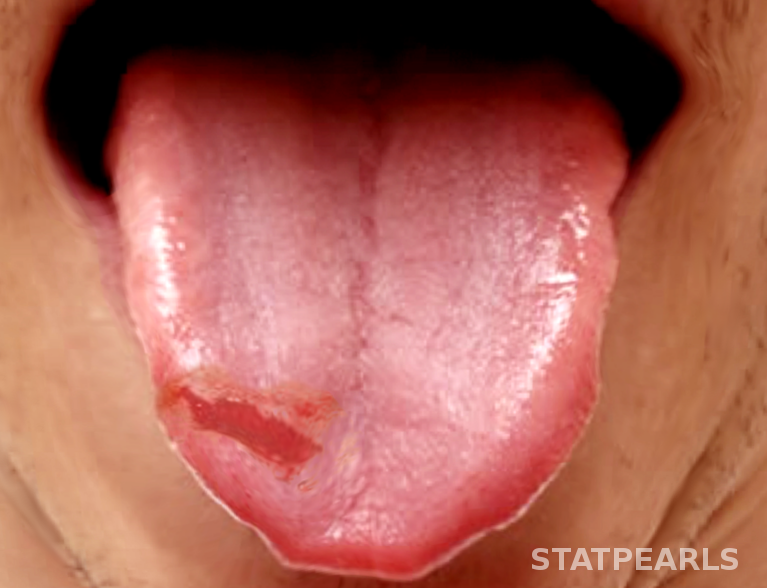[1]
George CLS, Theesfeld SSN, Wang Q, Hudson MJ, Harper NS. Identification and Characterization of Oral Injury in Suspected Child Abuse Cases: One Health System's Experience. Pediatric emergency care. 2021 Oct 1:37(10):494-497. doi: 10.1097/PEC.0000000000001715. Epub
[PubMed PMID: 30601344]
Level 3 (low-level) evidence
[2]
Beena JP. Management of tongue and lip laceration due to dystonia in a 1-year-old infant. Journal of the Indian Society of Pedodontics and Preventive Dentistry. 2017 Jan-Mar:35(1):90-93. doi: 10.4103/0970-4388.199223. Epub
[PubMed PMID: 28139490]
[3]
Costacurta M, Benavoli D, Arcudi G, Docimo R. Oral and dental signs of child abuse and neglect. ORAL & implantology. 2015 Apr-Sep:8(2-3):68-73. doi: 10.11138/orl/2015.8.2.068. Epub 2016 Jul 25
[PubMed PMID: 27555907]
[4]
Woo SW, Do SH. Tongue laceration during electroconvulsive therapy. Korean journal of anesthesiology. 2012 Jan:62(1):101-2. doi: 10.4097/kjae.2012.62.1.101. Epub 2012 Jan 25
[PubMed PMID: 22323965]
[5]
Vaught B, Spellman J, Shah A, Stewart A, Mullin D. Facial trauma caused by electronic cigarette explosion. Ear, nose, & throat journal. 2017 Mar:96(3):139-142
[PubMed PMID: 28346645]
[6]
Lamell CW, Fraone G, Casamassimo PS, Wilson S. Presenting characteristics and treatment outcomes for tongue lacerations in children. Pediatric dentistry. 1999 Jan-Feb:21(1):34-8
[PubMed PMID: 10029965]
[7]
Das UM, Gadicherla P. Lacerated tongue injury in children. International journal of clinical pediatric dentistry. 2008 Sep:1(1):39-41. doi: 10.5005/jp-journals-10005-1007. Epub 2008 Dec 26
[PubMed PMID: 25206087]
[8]
Seiler M, Massaro SL, Staubli G, Schiestl C. Tongue lacerations in children: to suture or not? Swiss medical weekly. 2018 Oct 22:148():w14683. doi: 10.4414/smw.2018.14683. Epub 2018 Oct 28
[PubMed PMID: 30378089]
[9]
Balasubramanian S, Paneerselvam E, Guruprasad T, Pathumai M, Abraham S, Krishnakumar Raja VB. Efficacy of Exclusive Lingual Nerve Block versus Conventional Inferior Alveolar Nerve Block in Achieving Lingual Soft-tissue Anesthesia. Annals of maxillofacial surgery. 2017 Jul-Dec:7(2):250-255. doi: 10.4103/ams.ams_65_17. Epub
[PubMed PMID: 29264294]
[10]
Kazzi MG, Silverberg M. Pediatric tongue laceration repair using 2-octyl cyanoacrylate (dermabond(®)). The Journal of emergency medicine. 2013 Dec:45(6):846-8. doi: 10.1016/j.jemermed.2013.05.004. Epub 2013 Jul 1
[PubMed PMID: 23827167]
[11]
Steele MT, Sainsbury CR, Robinson WA, Salomone JA 3rd, Elenbaas RM. Prophylactic penicillin for intraoral wounds. Annals of emergency medicine. 1989 Aug:18(8):847-52
[PubMed PMID: 2502938]
[12]
Mark DG, Granquist EJ. Are prophylactic oral antibiotics indicated for the treatment of intraoral wounds? Annals of emergency medicine. 2008 Oct:52(4):368-72
[PubMed PMID: 18819178]
[13]
Armstrong BD. Lacerations of the mouth. Emergency medicine clinics of North America. 2000 Aug:18(3):471-80, vi
[PubMed PMID: 10967735]
